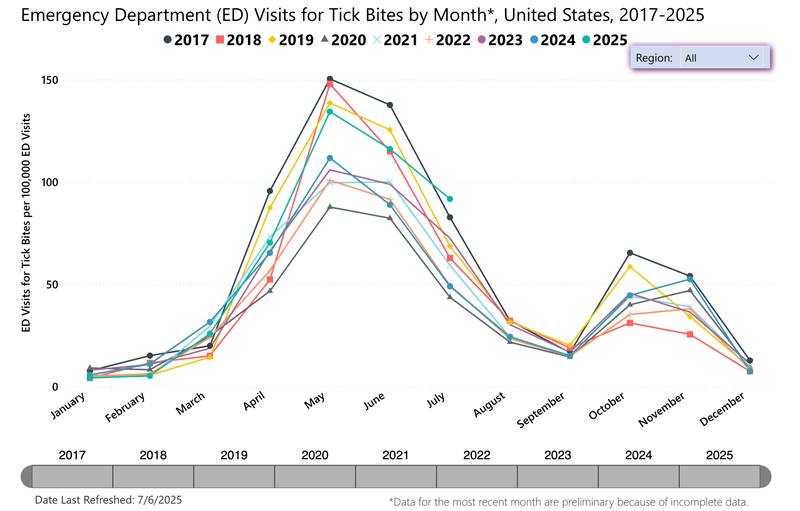
NEW YORK (1010 WINS) -- Emergency room visits for tick bites have spiked in the U.S. this summer, with the Tri-State area especially vulnerable, according to health data.
July has seen the highest number of tick-related ER visits since 2017 across the country, according to a dashboard from the Centers for Disease Control and Prevention. While the number of visits shows the typical annual trend of tick-related visits peaking in May and then dropping in June, levels remain at their highest level going back at least eight years—at just under 100 tick-related visits per 100,000 ER visits.
People in the Tri-State face a significant risk of tick bites, according to the Fordham Tick Index. The index estimates the risk of a tick bite in Southern New York, Connecticut and northern New Jersey is a 9 out of 10, indicating “high risk.”
And city folks are not immune—ticks have been found in all five boroughs of NYC.
The increase in tick bites could be attributed to the explosion of the tick population in the Northeast. According to the New York State Integrated Pest Management program, the rise in tick numbers started with a bumper acorn crop in 2023, leading to a surge in mice and deer, which are ideal hosts for ticks.

Elderly adults and young children are the most vulnerable for tick bites, with the CDC reporting those under 10 and over 70 years old having the highest rates of ER visits.
Ticks can transmit a number of diseases through their bites, including Lyme disease and Rocky Mountain Spotted Fever. Symptoms of bites include fever, chills, headaches, fatigue and muscle aches.
The CDC recommends avoiding wooded areas, high grass and leaf litter, and staying in the center of the trail while hiking. It also recommends Environmental Protection Agency registered insect repellents that contain DEET, Picaridin, or other EPA-approved ingredients. Outdoor clothing and gear should be treated with permethrin, and those planning to use sunscreen and insect repellent should apply the sunscreen before the repellent is applied.
Don’t forget your furry family members when trying to prevent tick bites.
Veterinarian Dr. Carly Fox at the Schwarzman Animal Medical Center on the Upper East Side says she sees tick-borne illness every day.
“We definitely have been seeing a bunch more of it, especially now with people traveling with their pets,” Dr. Fox said.
To keep the bugs at bay, Dr. Fox’s top tip is to treat your pup with a year-round flea and tick prevention medicine. Regularly brushing your K9’s coat, and thorough skin checks after walks are also key. If you see a creepy crawly on your pet: pick up those tweezers and get ready to pluck.
“Try to grab it as close to your pet’s skin as you possibly can, with one swoop motion, with one very quick yank,” Dr. Fox says.
Dr. Fox says even if you miss the head on your pull, as long as you remove the body, the tick can’t infect anymore and eventually the head will fall off.
